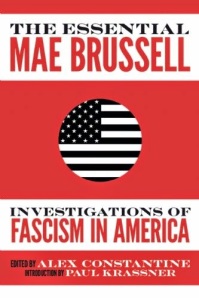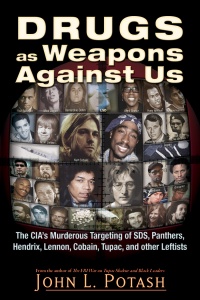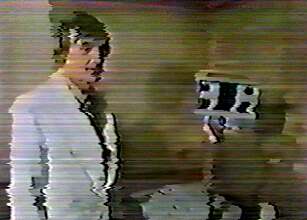Alex Constantine - September 25, 2014
The Essential Mae Brussell: Investigations of Fascism in America
edited by Alex Constantine
Feral House, 359 pp, $18.95
Drugs as Weapons Against Us
by John Potash
Trine Day, 420 pp, $18.60
It was a masterstroke of Quentin Tarantino’s film Inglorious Basterds to make a point of Nazi flight in the wake of a losing war. Lt. Aldo Raine (Brad Pitt), after learning that a Nazi captive is going to burn his uniform and never wear it again, informs him: “Yeah, we don’t like that. We like our Nazis out in the open,” right before carving a swastika into his forehead. Then, in the immensely satisfying end of the film, Aldo does the same to Colonel Hans Landa (Christoph Waltz), an officer who has made a deal to ensconce himself into the loving arms of the U.S. military. In the opening scene, Landa describes the Jewish people as rats; but in the end, it is Landa who is the rat, scrambling to desert the sinking Reich.
In watching the film, I recognized that the ending might be more satisfying for me than for some others, because many people do not know that Nazi officers and scientists flooded into the U.S. after World War II or how much influence they had over our history. Following the “good war,” the Pentagon and the CIA seemed hell-bent on giving cover to as many Nazis as possible. Some of them went into the U.S. Army historical division (the person who wrote the official Pentagon history of World War II was an official historian of the Reich) and others were scientists who would hold the chief positions at NASA and elsewhere for decades yet to come.
One character who did escape to America after the war was Reinhard Gehlen, where he became a willing instrument of the military establishment’s desire for a Cold War. CIA Director Allen Dulles funneled over $200 million to Gehlen. The idea was that Gehlen would use his old contacts to set up lines of information against the Soviets, while also training mercenary forces to fuel revolutionary movements with Russia. (Does this sound familiar?) Indeed, the CIA itself (which was created in 1947) was largely a combination of the old OSS (Office of Strategic Services) and Gehlen organization members. (Brussell 61) Additionally, as Mae Brussell notes in a new collection of her work put out by Feral House, “Some of [Gehlen’s] spies were schooled at the CIA’s clandestine base in Atsugi, Japan, where, in 1957, a young Marine named Lee Harvey Oswald was posted to the U-2 spy plane operation there.” (Brussell 23)
Mae Brussell has been described as the Queen of Conspiracy numerous times, which is a belittling nickname even if not expressed with such intent. She was, instead, one of the most brilliant intuitive thinkers who ever lived, and legendary at analysis. I never met her, alas, but heard many stories about her from my friend John Judge, as she and Penn Jones were his mentors. And while recordings of Mae are easy to find (the best collection can be accessed at www.worldwatchers.info, along with other Mae-related material), print has been rare. This new collection, edited by Alex Constantine, contains her most well-known pieces and examples of her prodigious facility. Having the book in print is also nice for those who wish to slowly digest the material, as listening to her radio shows can be challenging for the uninitiated as she zips from topic to topic.
What Brussell specialized in was milieu. She figured out who the players were in any situation she investigated, then who was related to whom, and who was connected to whom, and eventually she revealed the dark tunnels underneath the American dream. As she discovered, the fascists rule in secret while our Punch and Judy “democracy” keeps people distracted. Her ability to analyze events this way made her prescient, as when she warned Mary Jo Kopechne’s family that she was about to be killed shortly before Chappaquidick, or even writing a warning letter to Richard Nixon.
There are other observations sprinkled throughout the book with deep consequences. For instance, she mentions in passing that Clay Shaw, the subject of the Garrison trial and the later Oliver Stone film JFK, happened to die a few weeks after being publicly outed as a CIA asset in Victor Marchetti’sThe CIA and the Cult of Intelligence. (B 115) Like Penn Jones, Brussell did a great deal of work on suspicious deaths, and the timing of such deaths. She also observed that Hale Boggs, a Warren Commission member who expressed doubts about the final report’s conclusions, died one month after the Watergate arrests were made, in a plane crash. According to a Los Angeles Star story, she points out, Boggs was planning to make public links between the Kennedy assassination and Watergate. (B 113)
Brussell also wrote astonishing exposes of CIA operations such as the Symbionese Liberation Army’s kidnapping of Patty Hearst, which occupies a large section of the second half of the book, and even the deaths of West Coast rock and roll stars. As she points out, the two biggest bands of the era became associated with murder and hate – the Beatles via Vincent Bugliosi’s ridiculous conspiracy theory regarding Charles Manson, and the Rolling Stones via the Hell’s Angels murder of an unstable fan during the Altamont concert. (B 277)
What is the purpose of all these intrigues? She relates it to the underlying white power structure. As she puts it:
Competition for jobs between Indians, Blacks, and Chicanos is caused by a racist power structure in this country that refuses to allow jobs in the first place. IQ tests have been proven to be racist, thereby dropping off otherwise qualified students. By keeping minorities out of the professions except entertainment and athletics, the white community can keep their residential areas white, their schools white, their churches white, perpetuate the racism. (B 133)
Despite the articles in this book being decades old, none feel out of date. They feel more relevant than ever. Indeed, what has happened is that the power structure has gotten better at it. They’ve turned pro, both in a raw political sense but also in a cultural sense. The list of musicians that Brussell talks about is sobering: Hendrix, Joplin, Morrison, Phil Ochs, Gram Parsons, Lennon, and Otis Redding, among others. Is there anyone on the current cultural scene of that quality and impact? The obvious answer is no. When Lennon looked like he was getting ready to re-enter the mainstream, he was gunned down by another lone nut, which America seemingly specializes in producing. In response to this, Brussell has the single best advice I have ever read about such murders:
When someone is gunned down who is controversial, has political enemies, is hated by the wealthy and well-organized religious movements, and is an open opponent of government policies at home and abroad, that kind of murder requires much more inquiry into the background of the assassin. (B 284)
Exactly.
As if to prove the timeliness of Brussell’s observations, a new book – Drugs as Weapons Against Us by John Potash – will be coming out in November on Trine Day. Potash, who previously authored The FBI War Against Tupac Shakur, states in his book that he is building on the work of other researchers such as Peter Dale Scott, Brussell, and Constantine, the editor of The Essential Mae Brussell. There is a slight difference in focus as explained by the title Potash gave to his work, but it fits snugly alongside in terms of the research and point of view.
Potash tackles a broad spectrum of topics that converge on the topic of drugs, with an emphasis on the 1960s to the present. He first sets out some of the historical background of the opium wars and then quickly gets into government experimentation and abuse of mind-altering chemicals. And it’s here that Potash may create some controversy with readers of his book: he doesn’t support marijuana use or LSD use for mind expansion. As he points out, the CIA used the latter for purposes such as disorientation and truth extraction, but not for achieving higher levels of consciousness (Potash 32). He even quotes William S. Burroughs, famed author and heroin addict, as saying “LSD makes people less competent.” (P 37)
The book also suggests that Ken Kesey and Tim Leary may have been (unknowingly?) doing the government’s bidding in promoting drug use. Kesey himself actually participated in an MK-ULTRA (mind control) experiment in 1960. In describing the Magic Bus, Potash notes with interest several people connected to it who had military and/or blueblood backgrounds, and whose primary function seemed to be financing and encouraging figures such as Neal Cassady and Kesey. Further, what would somebody like the CIA’s John Gittinger be doing at Acid Test parties featuring the Grateful Dead? How did the Grateful Dead break out of the San Francisco scene to become a national success? The answers are both convoluted and fascinating, and in the book.
Drugs as Weapons Against Us gradually throws up a pattern constituting a street-level cultural war. COINTELPRO went after movements like the Black Panthers and targeted individuals like Dr. King and Malcolm X; at the same time, the CIA infiltrated the music scene. Many people find this difficult to believe – why would government forces be interested in someone like Jimi Hendrix, for example?
Scotland Yard claimed to quote Hendrix’s attending doctor, Dr. John Banister, saying Hendrix was ‘dead on arrival…[dying] in the ambulance or at home.’ The ambulance workers denied this. The hospital’s official report had Hendrix’s hospital arrival time as 11:45 and pronounced dead at 12:45. [Monika] Danneman claimed Hendrix was alive when the ambulance workers took Hendrix from their apartment. If Hendrix was dead on arrival, what happened during that hour? Scotland Yard couldn’t give Danneman an answer. When she asked what Dr. Bannister had to say about it, Scotland Yard told her that he had been struck off England’s official medical register of all doctors in the country, without any further explanation. (P 145)
At the same time, Hendrix’s manager, Mike Jeffery, had connections with the Mafia and FBI and had formerly worked for MI6, Britain’s intelligence agency. (P 146) There is more, a great deal more, and the devil is most certainly in the details. It’s an incredible story, but just one of a hundred in Drugs as Weapons Against Us.
Potash also takes us through the attacks on hip-hop artists, Panther leaders, Bob Marley, and in a startling set of chapters, the murder of Nirvana frontman Kurt Cobain. He also brings us up to date by describing how an unknown party dosed people with acid at Burning Man events and comparing it to the Grateful Dead’s long association with LSD. It is literally true that the year after Jerry Garcia died and touring stopped, LSD use dropped considerably in the U.S. “Slate magazine writer Ryan Grim wrote, ‘For 30 years, Dead tours were essential in keeping many LSD users and dealers connected, a correlation confirmed by the DEA in a divisional field assessment from the mid-1990s.’” Fortunately for LSD dealers, the band Phish entered the gap to help keep their business rolling. (P 281-283)
The extraordinary scope and detail in Drugs as Weapons Against Us makes it difficult to summarize. Readable, compelling, and packed with stunning information, Potash’s book works both as a terrific introduction for the beginner and an excellent resource for the veteran researcher. It serves as a kind of textbook to modern American history, covering all the aspects history books typically ignore. Taken together with the Brussell volume, these are vital and necessary defenses of the mind against the idiotic, and sinister, propaganda fed to us daily by major media.
To Order the Books:










